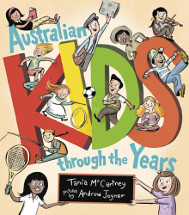Australian Kids through the Years by Tania McCartney

Ill. by Andrew Joyner. National Library of Australia, 2015. ISBN
9780642278593
(Age: 5-10) Recommended. Andrew Joyner's retro style illustrations
and Tania McCartney's fun presentation of information will make this
non-fiction picture book popular with children, teachers and parents
alike. McCartney also wrote the similarly presented An Aussie Year,
which illustrates twelve months in the year of children around
Australia. In Australian Kids through the Years, each double
page spread looks at children's lives, starting with larger blocks
of time (eg. 1800-1840s), and then looking at each decade
individually from the 1950s onwards. For each period, we are
introduced to a 'typical' girl and boy who then feature in the
following double page spread. Through speech bubbles, descriptive
labels within the illustrations and information textboxes, the
spreads tell the reader about the food, games, clothes and
activities that children of that period enjoyed. In the decades from
the 1950s onwards, what children watched on television also becomes
a main topic.
The pictures are rich in detail, filled with people playing, eating
and moving, providing plenty of things to look at and discuss.
Adults will get nostalgic about some of the games, toys, books and
television shows that are named or shown, which this will no doubt
spark rich conversations. Children will love questioning their
parents about some of the things they see on the pages, such as
games that are no longer popular, old technology and customs no
longer followed. They will also delight in recognising things that
have not changed over time. There is so much detail in here that it
invites readers to keep going back and picking out different things
each time. In the back of the book are photographs and images from
the National Library of Australia, which further illustrate each
period.
While there is an acknowledgment in the front of the book that 'For
tens of thousands of years, our first people lived in harmony with
the land', the portion of the book given to Indigenous Australian
children is small. In addition, the one page dedicated to them as
'first children' fails to emphasise how many generations of
Indigenous children lived on this land before European settlement,
and does not provide a year which would help to put this into
perspective. Despite this, the book successfully highlights and
celebrates the cultural diversity of Australian society and shows
how the social fabric of Australia has changed over time.
This is a resource perfect for teachers to use in discussions around
how childhood and life in Australia has changed over time, but will
also be wonderful for parents and children to share and discuss time
after time.
Nicole Nelson